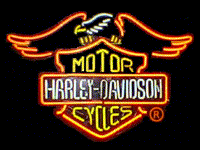
From
the primitive
single-cylinder motorcycle that started
the line to the famous V-twins to the
new fuel-injected engines that power the
modern bike, Harley-Davidson has become
synonymous with motorcycling and in
partcular cruisers. However, in the 90+
 years of
Harley-Davidson motorcycle
production the company has manfactured
nearly every type of two-wheeled
vehicle: huge cruisers and scooters,
racetrack bikes and tourers, trials
bikes and boardtrack racers, military
couriers and civilian "customs." It is
this rich heritage and wide
manufacturing experience that gives the
Harley-Davidson name its importance in
the world of motorcycling.
years of
Harley-Davidson motorcycle
production the company has manfactured
nearly every type of two-wheeled
vehicle: huge cruisers and scooters,
racetrack bikes and tourers, trials
bikes and boardtrack racers, military
couriers and civilian "customs." It is
this rich heritage and wide
manufacturing experience that gives the
Harley-Davidson name its importance in
the world of motorcycling.
More widely popular now than ever before -- the future looks bright for Harley-Davidson, despite strong competitive setbacks against Italian and particularly against Japanese motorcycles. With Harley-Davidson motorcycles fetching heavy premiums in both foreign and domestic markets, the money for research and development to improve the HD design is being directed once again towards making Harley-Davidson among the best motorcycles in the world.
THE
HARLEY
TIMELINE
BAB (Born Again
Biker) = "Someone who has recently
returned to riding after a period of
absence and really ought to get some
advanced training" Matt the Rat
Big End = Top Speed
Big Slab = Interstate Highway
Biker Friendly = "A business
establishment that doesn't treat you
like you have the plague when you walk
in wearin' leather
Blue Hairs: Elderly Cage
Drivers WATCHOUT!
Bubble Gum Machine = Law ahead, usually
patting the top of your helmet warns
those behind you that a cop is ahead.
Burnout = Spinning the rear wheel while
holding the front brake
Cage = Car
Cager = Car Driver
Canyon Carving = riding the twisties to
an extreme.
Chrome-Slut = Those addicted to putting
on more and more chrome, regardless of
the functionality.
Corn Snakes = Dried cornstalks that blow across the road especially at harvest
time.
Countersteering = turning the bike's
handlebars in one direction(at higher
speeds) and having it go in the opposite direction
Crack It = Turning up the throttle
Daytona 2000 - Main Street
Death Grip = usually how a first time
rider grabs the handle bars.
Econo-box, cage, dresser = Car
Endo = When you hit a log or something
and go back over front (opposite of
Odne)
Eat Asphalt = Crash
Fluid Exchange = Stopping for gas and to take a leak.
Daytona 2000
Get Off = Crash, "Eat Asphalt"
Ginmill = bar
Grabbing a Handful = Applying Brakes or
twisting the throttle in excess.
Hammer Down = Open the throttle fully or accelerate rapidly
High Siding = Wrecking a bike by
flipping it over. Usually caused by
releasing the rear break during a skid.
"I" = "Interstate, when on a long ride
one will say, I had to ride the "I" from such a place. Or like me I hate the
"I's". I'm a backroad rider."
Massachusetts
Insta-biker = Anybody who goes down to
the local bike shop and buys the Bike,
Gear and fake tattoos so they can hang
out with their new "Bros" (also Poser or Poseur)
Iron Butt 50CC = A coast to coast
endurance ride, for example,
Jacksonville Florida to San Diego
California in under 50 hours
Iron Butt
Rat Bike = "Bike made from several
machines and kept on the road using as
cheap as possible and painted matt
black. now has a class of its own and
defined as anything Mad Max would shoot at." Jamie Bye
RUB = Rich Urban Biker. A term usually
used by real Harley Bikers to describe
the weekend wannabe accountant types who buy a Harley 'cause they can and the
status of it, but couldn't tell a
camshaft from a brake pad.
Rubberside = Towards the bottom of the
bike, or bottom area of a part or
component
Shiny Side Up = Drive Safe, Don't Lay
the Bike Down
Sidewalk Commando = Outdated term for
motorcycle wannabe. Vaguely insulting to Norton owners.
SO = Significant Other
(usually refers to someone's wife or
husband)
Stewartized = When some Bikers take
great pains and expense to color
coordinate their bike colors, leathers,
helmet, boots, gloves. Named after
Martha Stewart
Tagged = as in tag you're it.old term for finding out there is a cop or narc
undercover in your bar or club. (South)
Twisting The Wick = Speeding up, Roll on the throttle.
Wannabe = Name used by some Harley
riders for non-Harley riders riding a
Harley-look-alike clone
Weekend Warrior = Insta-biker types
Wing Comander = Police term for sports
bike rider as in missed the runway Wing
Comander ----Courtesy of MattBIKER
SLANG
